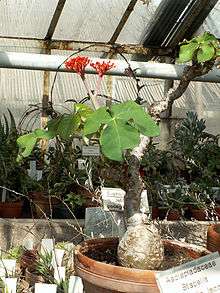Jatropha podagrica
Jatropha podagrica is a succulent plant in the family Euphorbiaceae.[1][2] It is native to the tropical Americas but is grown as an ornamental plant in many parts of the world due to its unusual appearance. Common names include Gout Plant, Gout Stalk, Guatemalan Rhubarb, Coral Plant, Buddha Belly Plant, Purging-Nut, Physic Nut, Goutystalk Nettlespurge, Australian Bottle Plant, and Tartogo.[3][4][5][6]
| Jatropha podagrica | |
|---|---|
 | |
| Scientific classification | |
| Kingdom: | Plantae |
| Clade: | Tracheophytes |
| Clade: | Angiosperms |
| Clade: | Eudicots |
| Clade: | Rosids |
| Order: | Malpighiales |
| Family: | Euphorbiaceae |
| Genus: | Jatropha |
| Species: | J. podagrica |
| Binomial name | |
| Jatropha podagrica | |
Description
J. podagrica is a caudiciform perennial herb growing up to 1 metre (3 feet) tall.[3][4][5] The grey-green, knobby, swollen caudex has a bottle-like appearance, giving rise to some of the common names. Leaves are held on long fleshy yet stout petioles which emerge from the tip of the stem and radiate in all directions. Leaves are peltate and 3 or 5 lobed. Dense clusters of small, orange-red, flowers are held above the leaves on long slim peduncles. The clusters carry both male and female flowers and flowering continues for most of the year.[3][4][7] Fruit are green capsules at first, becoming blackish-brown at maturity, when they explode and scatter their seeds up to 4 metres (13 feet) away.[4][5]
When cut, the plant exudes a copious sticky sap which may cause dermatitis on contact.[7]
Cultivation
The swollen caudex, showy leaves, and colourful flowers make J. podagrica an attractive ornamental, and it is grown as an indoor plant in many parts of the world.
Uses
There are many uses of J. podagrica in folk medicine, including as an analgesic, tonic, aphrodisiac, purgative, laxative, and to treat infections, intestinal worms, snakebite, gout, and more.[3][4][5][8] Other uses include tanning, dye making, soap making, biofuel, fish poison, lamp lighting, and fertiliser.[3][4][5]
Additionally, a number of research projects have sought to identify medicinally useful compounds from J. podagrica.[9][10][11]
Toxicity
All parts of the plant are considered toxic, in particular the seeds. The main toxins are a purgative oil and a phytotoxin or toxalbumin (curcin) similar to ricin in Ricinis.[5][12]
Galleries
 Jatropha podagrica
Jatropha podagrica- Buddha belly plant from Pondicherry
 Flower of jatropha podagrica
Flower of jatropha podagrica Close-up of Jatropha podagrica
Close-up of Jatropha podagrica Fruit of Jatropha podagrica
Fruit of Jatropha podagrica Flower of Jatropha podagrica
Flower of Jatropha podagrica Jatropha podagrica flowers leaves
Jatropha podagrica flowers leaves Jatropha podagrica
Jatropha podagrica.jpg) Jatropha podagrica in Thailand
Jatropha podagrica in Thailand.jpg) Jatropha podagrica Close up Flowers
Jatropha podagrica Close up Flowers
References
- "Jatropha podagrica Hook. — The Plant List". www.theplantlist.org. Retrieved 2020-01-13.
- "Tropicos | Name - !Jatropha podagrica Hook". www.tropicos.org. Retrieved 2020-01-13.
- "Jatropha podagrica". www.llifle.com. Retrieved 2020-01-13.
- "Gouty stem of Jatropha podagrica (Buddha Belly Plant) | John&Jacq~s Garden". Retrieved 2020-01-13.
- "Buddha belly plant, Jatropha podagrica, Gout plant, Fo du shu : Philippine Medicinal Herbs / Alternative Medicine". www.stuartxchange.org. Retrieved 2020-01-13.
- "Jatropha podagrica - Australian Bottle Plant". www.flowersofindia.net. Retrieved 2020-01-13.
- Queensl, Children's Health (2017-07-18). "Guatemala rhubarb (Jatropha podagrica) | Children's Health Queensland". Children’s Health Queensland. Retrieved 2020-01-13.
- "Jatropha podagrica in Flora of China @ efloras.org". www.efloras.org. Retrieved 2020-01-13.
- Bawm, Saw; Tiwananthagorn, Saruda; Lin, Kyaw San; Hirota, Junichi; Irie, Takao; Htun, Lat Lat; Maw, Ni Ni; Myaing, Tin Tin; Phay, Nyunt; Miyazaki, Satoshi; Sakurai, Tatsuya (2010). "Evaluation of Myanmar Medicinal Plant Extracts for Antitrypanosomal and Cytotoxic Activities". Journal of Veterinary Medical Science. advpub: 0912110098–0912110098. doi:10.1292/jvms.09-0508.
- Aiyelaagbe, O. O.; Adesogan, E. K.; Ekundayo, O.; Adeniyi, B. A. (2000). "The antimicrobial activity of roots of Jatropha podagrica (Hook)". Phytotherapy Research. 14 (1): 60–62. doi:10.1002/(SICI)1099-1573(200002)14:13.0.CO;2-B. ISSN 1099-1573.
- Aiyelaagbe, Olapeju O.; Adesogan, Kayode; Ekundayo, Olusegun; Gloer, James B. (2008). "ChemInform Abstract: Antibacterial Diterpenoids from Jatropha podagrica Hook". ChemInform. 39 (6). doi:10.1002/chin.200806166. ISSN 1522-2667.
- "Jatropha podagrica (PIM 647)". www.inchem.org. Retrieved 2020-01-13.
| Wikimedia Commons has media related to Jatropha podagrica. |